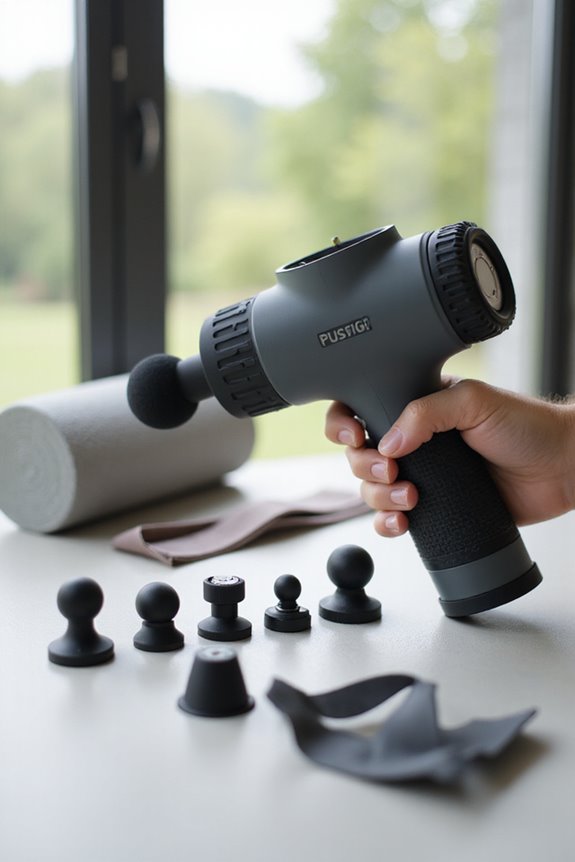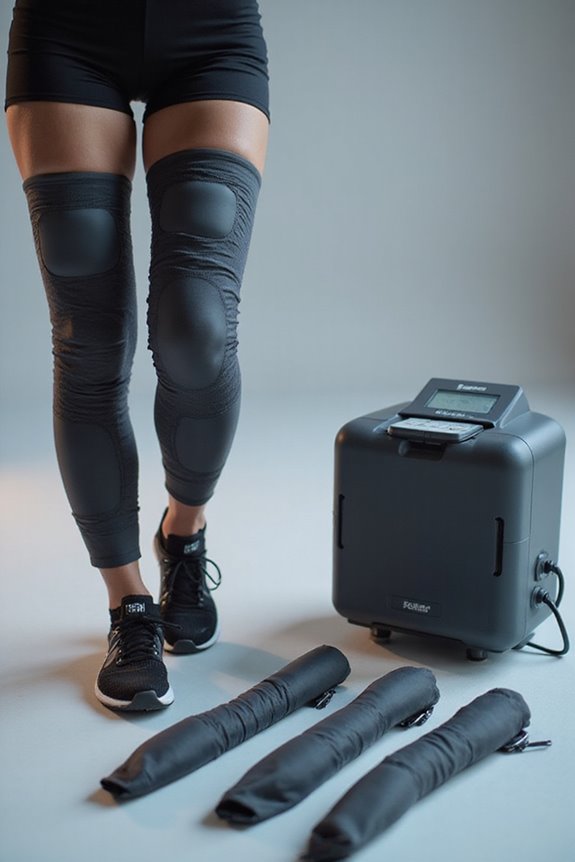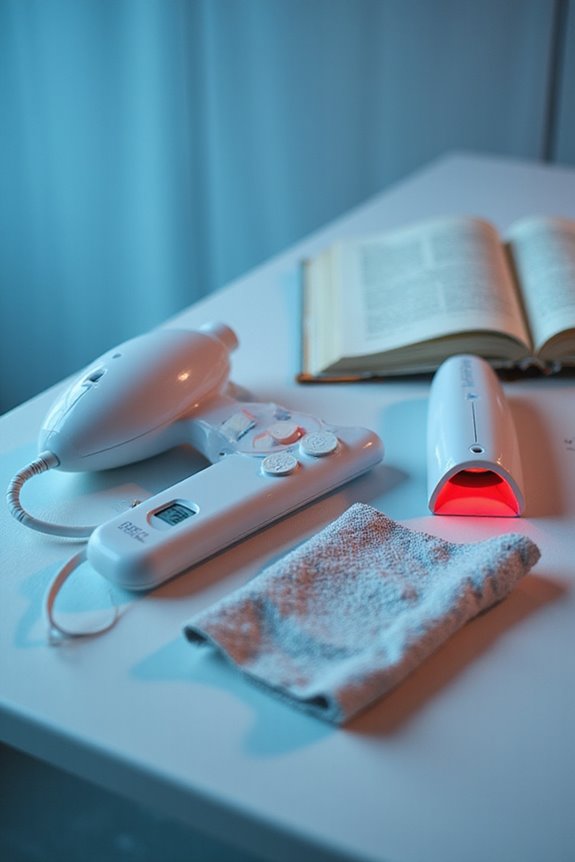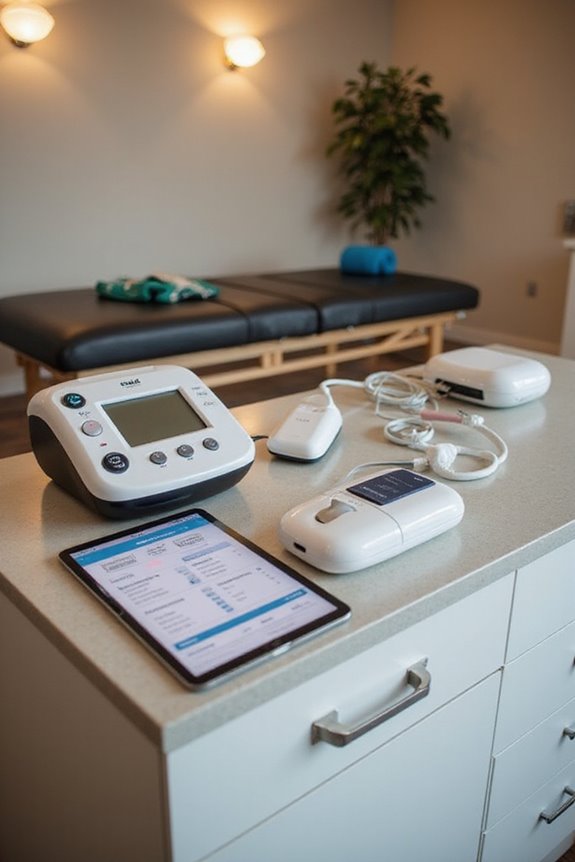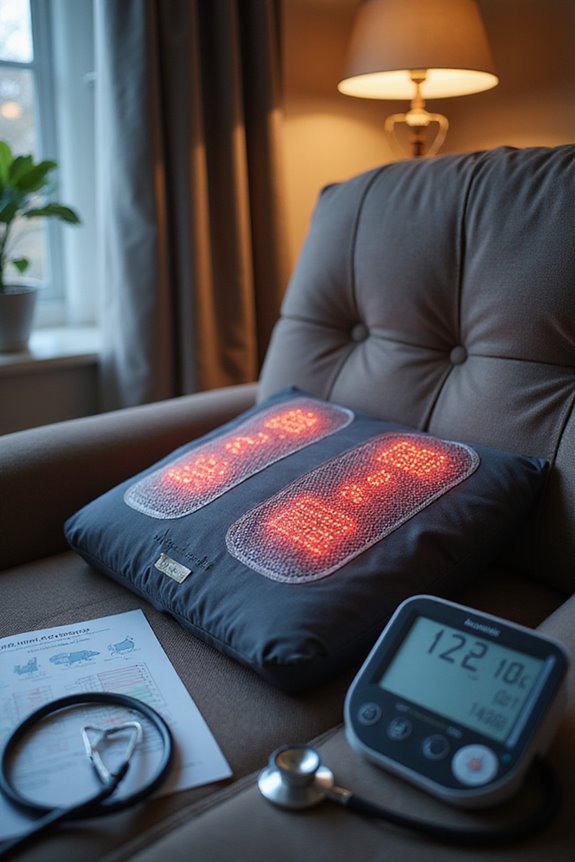To properly use a percussion gun, maintain a firm yet relaxed grip. Move slowly over targeted muscles for ideal recovery. Focus on large muscle groups, avoiding sensitive areas and bony prominences. Limit usage to 2 minutes per muscle group, with total sessions lasting 15-30 minutes. Use adjustable intensity settings; start low and increase gradually. Consult professionals if issues arise, such as sharp pain or swelling. For detailed guidance on frequency and targeting, further insights are available.
Key Takeaways
- Maintain a firm yet relaxed grip while controlling pressure on the targeted muscles during use.
- Move slowly over larger muscle groups, limiting each area to a maximum of 2 minutes for safety.
- Start with the lowest speed to assess comfort, adjusting intensity based on muscle response.
- Use interchangeable attachments to effectively target specific muscle groups while avoiding bony areas.
- Consult a professional if you have any underlying conditions or experience sharp pain during use.
Understanding the Basics of Percussion Guns
Percussion guns represent a significant advancement in firearm technology, characterized by their unique ignition system. These firearms utilize an external primer known as a percussion cap, which plays an essential role in ignition mechanics.
- Core Components: The primary parts include a hammer, a nipple, and the percussion cap. The nipple serves as a conduit, channeling the ignited primer to the barrel’s powder charge.
- Ignition Process: When the hammer strikes the percussion cap, it detonates the explosive inside, creating a spark that ignites the gunpowder.
- Historical Significance: This innovation, introduced in the early 1820s, replaced flintlock mechanisms, offering enhanced reliability and safety in varying weather conditions, thereby transforming muzzle-loading firearms.
Proper Technique for Effective Use
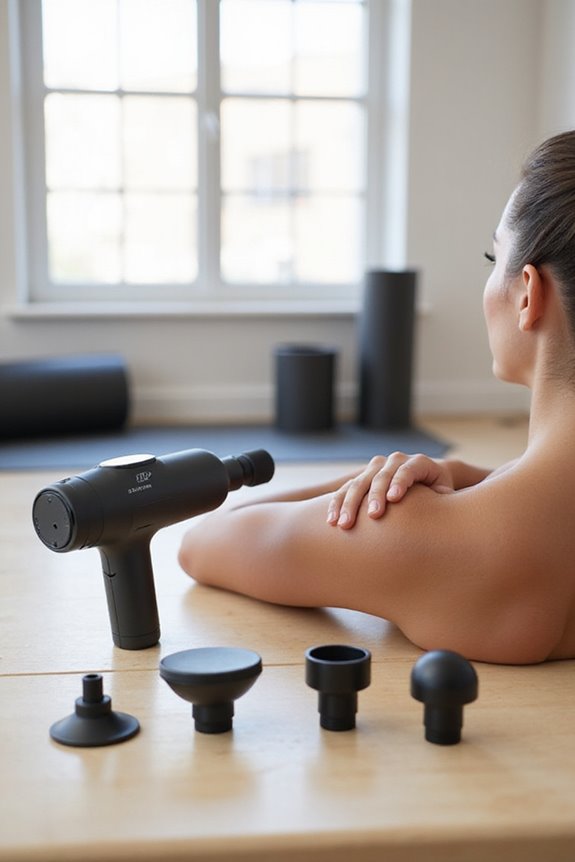
Effective use of a percussion gun requires a thorough understanding of proper techniques to maximize benefits while minimizing risk.
Grip Technique
– Maintain a firm yet relaxed grip to allow the device to deliver pressure without excess manual force.
Movement Guidelines
- Move the gun slowly over targeted muscles to avoid tissue damage.
- Focus on muscle bellies, avoiding bones and joints for safety.
Targeting Muscle Groups
- Concentrate on larger muscles, like glutes and quads, for ideal recovery.
- Use smaller attachments for delicate areas, ensuring appropriate muscle coverage.
Pressure Management
- Rely on the gun’s motor to provide force, adjusting speed based on muscle tolerance.
- Monitor muscle response, decreasing intensity if discomfort occurs, ensuring effective and safe usage. Additionally, always ensure that the adjustable speed settings are utilized for a tailored experience that caters to individual comfort levels.
Time Limits for Each Session
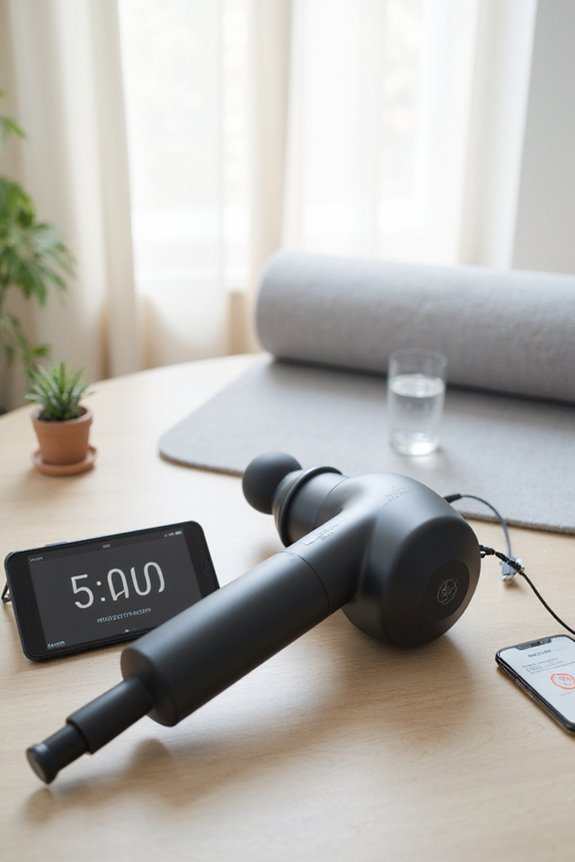
Time limits are critical for optimizing the use of a percussion gun, ensuring safety and effectiveness.
Session Duration
- Maximum duration per muscle group: 2 minutes.
- Total session length: 15 to 30 minutes, depending on user experience.
- Beginners should start at 15 minutes to allow for muscle adjustment.
Frequency of Use
- Use the percussion gun 2-3 times daily on different muscle groups.
- For muscle maintenance, aim for 2-3 times weekly.
Recovery Intervals
- Allow at least 48 hours between sessions targeting the same muscle group.
- Monitor muscle response to prevent overuse injuries and enhance muscle recovery.
Adhering to these limits maximizes the benefits of percussion therapy while minimizing risks such as bruising and tissue damage.
Target Areas for Safe Application
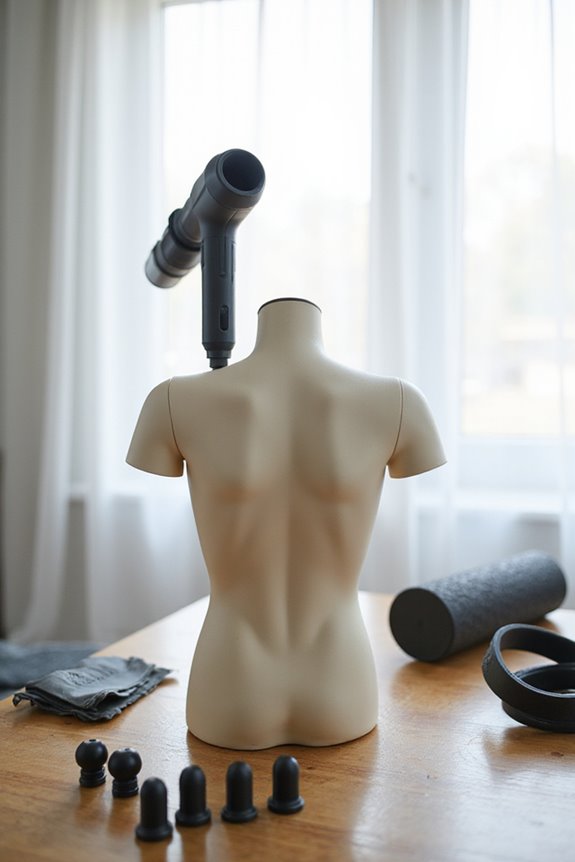
The effectiveness of a percussion gun largely depends on its application to appropriate target areas. Safe application focuses primarily on large muscle groups, which can tolerate deeper percussion without injury. Recommended target muscle groups include:
- Quadriceps
- Hamstrings
- Glutes
- Calves
- Upper back muscles
These areas respond well to percussion, aiding in soreness reduction and flexibility improvement. It is essential to avoid bony prominences, such as the spine and kneecaps, to prevent discomfort and potential injury. Sensitive zones, including the neck and face, should also be avoided. For optimal outcomes, percussion should be applied to the muscle belly, with limited time per spot, ensuring a careful and informed approach to maximize benefits while minimizing risks. Additionally, utilizing interchangeable heads can enhance the targeting of specific muscle groups for more effective treatment.
Adjusting Intensity and Speed Settings
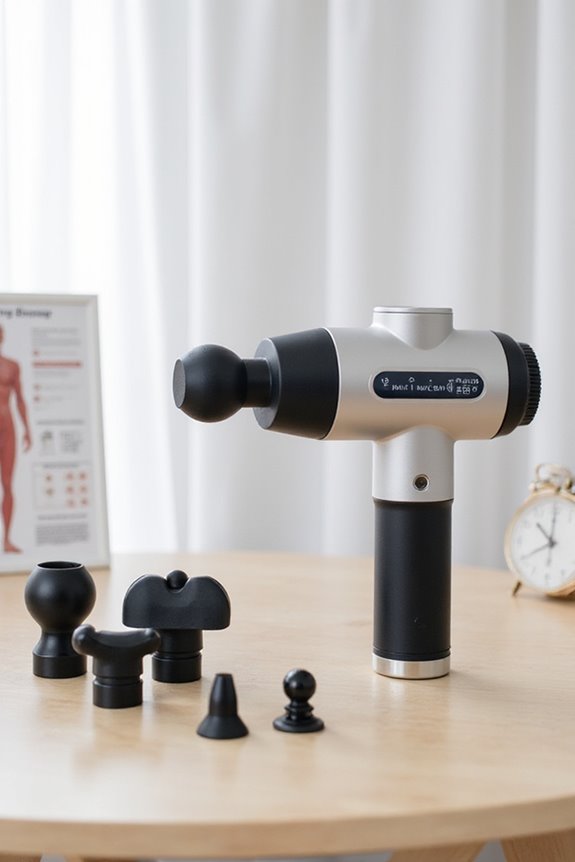
Adjusting intensity and speed settings on a percussion gun is essential for achieving ideal results while minimizing the risk of injury.
- Starting Low: Begin with the lowest speed to assess comfort and monitor muscle response. Gradually increase intensity only after the body acclimates.
- Speed Adjustments: Use moderate to high speeds for larger muscle groups, while slower speeds are suited for smaller areas to avoid overstimulation.
- Pressure Management: Maintain a light grip to let the device work effectively, avoiding excessive pressure.
- Incremental Changes: Make speed adjustments in small increments, and reduce speed if discomfort arises.
Additionally, understanding power and speed options is critical to optimize the effectiveness of your percussion massage experience.
Following these guidelines guarantees effective muscle treatment, contributing to overall wellness and enhancing recovery while safeguarding against potential injuries.
Frequency of Use for Best Results
Ideal frequency of use for a percussion gun is crucial for maximizing its benefits while minimizing potential risks. Frequency recommendations vary based on individual muscle condition and activity levels.
- For general users, once a week is optimal.
- Those with relaxed muscles may benefit from two sessions weekly.
- Individuals with chronically tight muscles should limit use to a few times monthly to avoid overstimulation.
Daily use is possible, but care is needed to limit sessions on a single muscle group to under two minutes. Pre-workout use can prepare muscles, while post-workout sessions assist recovery. Adjusting frequency based on personal tolerance and activity intensity guarantees effective and safe usage, enhancing overall muscle condition without adverse effects. Additionally, it’s important to consider the battery life and charging features of the massage gun to ensure it’s ready for use when needed.
Long-Term Considerations for Recovery
When considering long-term recovery, the use of a percussion gun offers several advantages that can enhance overall muscle health and function.
- Muscle Adaptability: Regular use promotes improved muscle tone, endurance, and flexibility, essential for long-term performance benefits.
- Rehabilitation Strategies: Percussion therapy can supplement standard rehabilitation techniques, targeting soreness and enhancing recovery from musculoskeletal conditions.
- Enhanced Recovery: Improved blood circulation and tissue mobility facilitate faster recovery from injuries and prevent re-injury by supporting muscle repair.
- Neuromuscular Control: Long-term application aids kinesthetic awareness and promotes injury prevention during movement.
- Monitoring Needed: Users should be cautious, avoiding bony areas and gradually increasing intensity to manage risk effectively. Additionally, incorporating adjustable speed settings can optimize the effectiveness of your recovery sessions.
Handling and Maintenance Tips
Effective handling and maintenance of a percussion gun are essential for maximizing its benefits and guaranteeing user safety.
Handling Techniques
- Grip firmly to control movement.
- Allow the device’s mechanism to provide pressure; avoid excessive force.
- Move slowly over muscle groups, spending 15 to 30 seconds per area.
- Limit focus on one spot to 20 seconds to prevent bruising.
Cleaning Procedures
– Clean the gun’s head and body regularly to prevent sweat and dirt buildup.
Storage Tips
- Store in a cool, dry place to preserve battery life.
- Inspect attachments for wear; replace as necessary.
- Follow manufacturer guidelines for charging to extend battery longevity.
Regular maintenance guarantees peak performance and safety during use. Additionally, using a percussion gun can enhance blood circulation and promote muscle recovery, similar to the benefits of shiatsu massagers.
When to Seek Professional Guidance
Understanding when to seek professional guidance regarding the use of a percussion gun is essential for guaranteeing both safety and effectiveness.
Indications for Professional Guidance
- Acute Injuries: Avoid use on muscle strains, sprains, or broken bones without medical advice.
- Underlying Conditions: Individuals with osteoporosis, high blood pressure, or vascular disorders should consult professionals for recommendations.
- Nerve Damage: Those with neuropathy must seek guidance to prevent irritation or injury.
Red Flags for Immediate Attention
- Symptom Monitoring: Sharp pain, numbness, or swelling after use necessitates cessation and consultation.
- Skin Reactions: Persistent bruising or irritation indicates potential misuse or underlying conditions requiring evaluation.
Engaging healthcare professionals guarantees safe usage and ideal therapeutic outcomes.
Frequently Asked Questions
Can I Use a Percussion Gun on My Pets?
Using a percussion gun on pets poses significant risks to their safety. Animal care requires specialized equipment; veterinary guidance is essential for ensuring proper treatment, as pets are more sensitive to vibrations and potential injuries.
Is a Percussion Gun Suitable for Elderly Individuals?
Coincidentally, elderly individuals seeking pain management should consider safety considerations when using percussion guns. Proper usage can enhance mobility and comfort, but caution is essential to avoid injury, ensuring a supportive approach to their wellness journey.
Can I Use It on Sore Muscles After a Workout?
Using a percussion gun on sore muscles after a workout can enhance muscle recovery and provide effective post-workout relief. Adhering to safety guidelines guarantees a supportive experience, fostering a sense of belonging in wellness communities.
How Do I Clean the Percussion Gun Attachments?
Studies show that proper maintenance techniques can extend device lifespan by 30%. Effective cleaning techniques for percussion gun attachments involve gentle wiping, submerging washable parts, and careful internal cleaning, ensuring peak performance and longevity for shared users.
What Should I Do if the Device Malfunctions?
When facing a malfunction, thorough troubleshooting is essential. Proper device maintenance, such as checking the battery and motor, can resolve issues. Consulting manuals or professionals fosters belonging within a community focused on effective device care and support.

